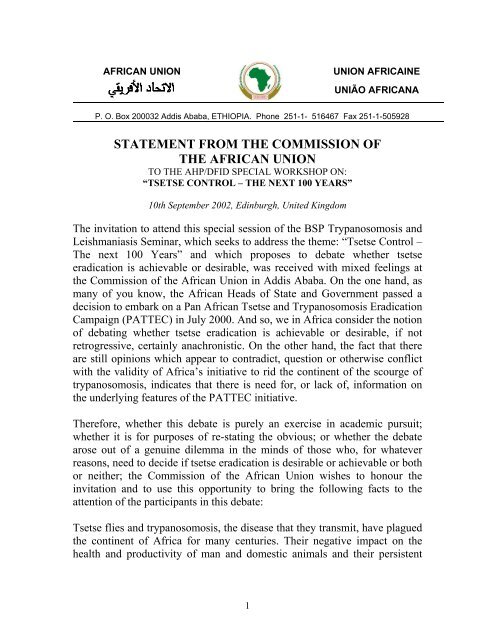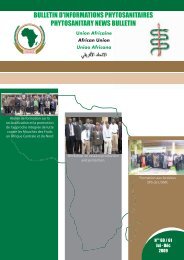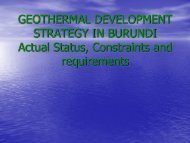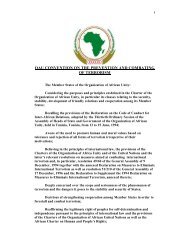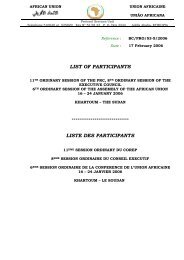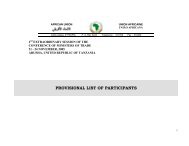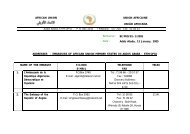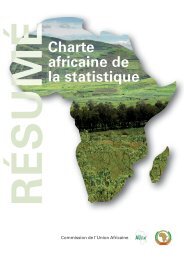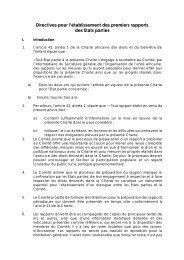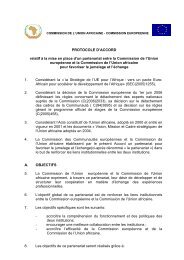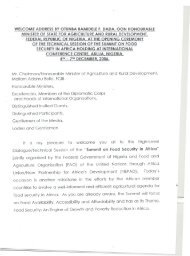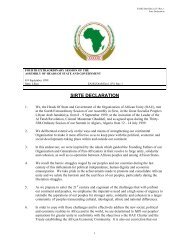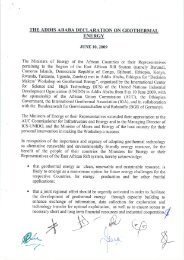AFRICAN UNION - Union africaine
AFRICAN UNION - Union africaine
AFRICAN UNION - Union africaine
Create successful ePaper yourself
Turn your PDF publications into a flip-book with our unique Google optimized e-Paper software.
<strong>AFRICAN</strong> <strong>UNION</strong><strong>UNION</strong> AFRICAINEUNIÃO <strong>AFRICAN</strong>AP. O. Box 200032 Addis Ababa, ETHIOPIA. Phone 251-1- 516467 Fax 251-1-505928STATEMENT FROM THE COMMISSION OFTHE <strong>AFRICAN</strong> <strong>UNION</strong>TO THE AHP/DFID SPECIAL WORKSHOP ON:“TSETSE CONTROL – THE NEXT 100 YEARS”10th September 2002, Edinburgh, United KingdomThe invitation to attend this special session of the BSP Trypanosomosis andLeishmaniasis Seminar, which seeks to address the theme: “Tsetse Control –The next 100 Years” and which proposes to debate whether tsetseeradication is achievable or desirable, was received with mixed feelings atthe Commission of the African <strong>Union</strong> in Addis Ababa. On the one hand, asmany of you know, the African Heads of State and Government passed adecision to embark on a Pan African Tsetse and Trypanosomosis EradicationCampaign (PATTEC) in July 2000. And so, we in Africa consider the notionof debating whether tsetse eradication is achievable or desirable, if notretrogressive, certainly anachronistic. On the other hand, the fact that thereare still opinions which appear to contradict, question or otherwise conflictwith the validity of Africa’s initiative to rid the continent of the scourge oftrypanosomosis, indicates that there is need for, or lack of, information onthe underlying features of the PATTEC initiative.Therefore, whether this debate is purely an exercise in academic pursuit;whether it is for purposes of re-stating the obvious; or whether the debatearose out of a genuine dilemma in the minds of those who, for whateverreasons, need to decide if tsetse eradication is desirable or achievable or bothor neither; the Commission of the African <strong>Union</strong> wishes to honour theinvitation and to use this opportunity to bring the following facts to theattention of the participants in this debate:Tsetse flies and trypanosomosis, the disease that they transmit, have plaguedthe continent of Africa for many centuries. Their negative impact on thehealth and productivity of man and domestic animals and their persistent1
impediment to land use and socio-economic development in most of Africahas been decried for now over 100 years.During these past 100 years, various attempts were made to solve or copewith the trypanosomosis problem. However, to this day the disease stillclaims tens of thousands of human lives and millions of livestock every yearand threatens over 60 million people in 37 countries of Sub-Saharan Africa.The tsetse fly still rules and wreaks havoc in about 10 million Km 2 ofAfrica's best pasture and agricultural land, stretching from Senegal in thenorth to South Africa in the south, condemning the wretched communities inits wake to death, chronic debility and perpetual abject poverty and causingmassive economic losses.This pathetic sad tale of human misery and its total unacceptability have,during these past few years, come under considerable scrutiny, with moreand more people continuing to question the morality behind the persistentlack of action on a problem, which everyone believes is totally preventable.A plethora of published information in books and journals, recordedtestaments of eminent scientists and other forms of available evidence showclearly that we have the technology to rid the continent of the problem oftsetse and trypanosomosis, once and for all. We have the technology toattract and catch tsetse flies. We have the technology to induce sterility andcause tsetse populations to crash; we have the technology to strike at tsetseflies from the air with split second surgical precision; many people agreethat we have the technology to kill the tsetse fly many times over. Every oneseems to agree that as far as enemies go, the tsetse fly is not only an easytarget, but also a particularly weak and vulnerable one. And so, one wonderswhether it is out of pessimism or cynicism or pragmatism or scepticism thatthe organisers of this debate can contemplate the prospects of tsetse controlin the next 100 years.We, in Africa and our friends and well-wishers elsewhere in the world havebeen asking ourselves several related questions. If we have all thesetechnologies or have access to these technologies; if there are all theseexperts and knowledgeable people who are technically competent toeliminate the problem of trypanosomosis once and for all, how come somepeople seem to accept the idea and prospect of having the tsetse fly aroundfor the next 100 years? If this is the 21st Century, and man has succeeded inmany fields of human endeavour, from engineering and technology feats anda booming inter-planetary tourism industry to splitting the atom and2
dissecting the human genome; how come our communities remain captive tothe shackles of their ecological circumstances and are condemned to diefrom diseases of the 19th Century?How can it be acceptable that a section of humanity can continue to sufferfrom a problem whose solution exists? Is it proper to be the cause ofavoidable ill? Why do we continue to debate issues that are obvious, askingquestions whose answers we already know, beating about the bush, when wecould go through the bush? Is it possible that we have been busy searchingfor the right answers, but perhaps asking the wrong questions? Actually,what is the problem? What is missing? What is wrong, why can’t we dosomething definitive and tangible to solve a problem, which every bodyagrees is crucially important, and which everybody agrees is dreadfullysimple to solve?One of the explanations to this engaging puzzle has been the failure toappreciate or recognise the significance of the tsetse and trypanosomosisproblem as a priority among the perennial priorities included on Africa'slong list of critical emergencies. The tsetse and trypanosomosis problemtends to be less appreciated because it occurs in rural areas and is found onlyin Africa. On a continent burdened by many other priorities, such as theAIDS pandemic, malaria, safe water, roads, and a multitude of otherdevelopment problems, it is easy to lose sight of a problem that does notattract the headlines. A problem which blends with its own effects andconsequences to become part of Africa's tragic ecology and vicious circle ofpoverty and diminished productivity. However, we all know that the tsetseand trypanosomosis problem is indeed a fundamental one, affecting not onlyour lives and livelihood, but the productivity of our land and livestock, aswell. It is instructive to note that, at one time, in the recent history of theAfrican continent, the threat and scourge of trypanosomosis commanded theattention and imagination of at least 5 imperial powers. Unfortunately,during the subsequent decades of post-independence Africa, leading up tothe present time, the importance and significance attached to the disease aswell as to the urgency and necessity to combat it, became largelyoverlooked, ignored or simply relegated to the charge and mercies of foreignintervention.The second reason, which has greatly contributed to the absence of tangibleaction against the disease has been the lack of a systematic approach or formof a commitment dedicated to the single objective of achieving the total3
elimination of the problem, on a sustainable basis. During the period sincethe early 1900s leading to the 1970s there were attempts, which succeeded inrendering many parts of Africa tsetse-free and trypanosomosis-free. Theseattempts were conducted military style with the singular purpose andobjective of achieving tsetse eradication, using approaches that employedarea-wide principles, which succeeded in eliminating the tsetse fly and thedisease from large areas in various parts of the continent. However, theevents that punctuated the political history of the African continentthroughout the 1960s, 1970s and 1980s (and some continuing to this day):characterised by wars, liberation movements, coups and counter coups, andother forms of upheavals that were associated with the metamorphosis of theformation of new independent states, paid their toll not only on the gains andachievements of earlier tsetse eradication campaigns, but also caused thereduction or stoppage of actual tsetse and trypanosomosis controlprogrammes and policies. Overtime, the earlier confident efforts andstrategies, which had originally been adopted and aimed at totallyeliminating the disease became replaced with the somewhat unclearobjectives aimed at controlling or containing the disease, whichsubsequently deteriorated to merely managing the disease. More recently weseem to have settled for the rather curious option of accepting to live withthe disease. This resigned and rather defeatist mentality was backed andcompounded by opinions from various quarters, suggesting that eradicationof the disease was neither achievable nor desirable. And obviously, debatessuch as the one being addressed in Edinburgh today have tended to createthe false and misleading impression that living with this disease is a viableoption. For a time this view was fuelled and enhanced by opinions paradedby principles and champions of, what can only be called, ecologicalimperialism, claiming that the tsetse fly is the principal protector of Africa'secosystems and therefore should not be touched. These views were used toblock, delay, oppose or otherwise frustrate any attempt aimed at tsetseeradication. These views were not necessarily malicious; they were probablysimply fallacious. Fallacious because they were built on the supposition thatif tsetse flies were to be removed from the large expanses of Africa'spresently uninhabited and undeveloped land, otherwise known as Africa'sGreen Desert, massive overgrazing would automatically follow, leading toencroachment and destruction of wildlife reserves and causing landdegradation. However, we know for a fact that areas that have been renderedtsetse-free show no evidence of any environmental damage or ecologicaldisruption. On the contrary, we can actually prove that the continuedpresence of the disease, causing overcrowding and competition for the4
limited tsetse-free land, is itself a significant environmental hazard thatthreatens ecological balance. Further, we know that people in tsetse-freeareas tend to actually stock fewer but higher productivity breeds oflivestock, not more. We also know that wild life parks are protected bylegislation, not by tsetse flies. And we know for a fact that communities intsetse-free areas are not only relieved of the costs of treating or preventingtrypanosomosis, but that they also experience gains in increased land,livestock and food productivity to an extent that no other single developmentscheme or policy can generate. And who, in God's name, can quarrel withthat, especially given Africa's poverty crisis and serious food securityquestions? We also know from experience that protection of even smallareas located within a major fly belt by regular tsetse control interventions isuneconomical. The many areas in different parts of Africa, in which tsetseeradication had actually been achieved, but which subsequently became reinfesteddemonstrate the need to guard against fly re-invasion from relicpopulations in the treated or neighbouring areas and lends emphasis to thenecessity of employing an area-wide approach, targeting the entire tsetseinfestation in a given area. The successful eradication of tsetse flies fromZanzibar, which was officially declared by the Government of Tanzania inSeptember 1997, was an important historical achievement that demonstratedthe feasibility and viability of tsetse eradication as an effective interventionmeasure against trypanosomosis. This achievement was made all the moresignificant by the fact that it came at a time when nearly the whole worldwas getting mobilized to the resigned pessimistic view that tsetse eradicationis not achievable, being urged to accept the fatalistic option of living withthe disease. The successful tsetse eradication model project in Zanzibar alsohelped to identify the practical details and define the modus operandirequired in the execution of similar tsetse eradication programmeselsewhere. Further, the post-tsetse eradication benefits, which have beenrecorded in Zanzibar, including improvements in milk production, reducedcosts in livestock husbandry and veterinary care, and certainly none of thedreaded negative consequences, e.g. land degradation or encroachment ongame reserves often speculated by those opposed to tsetse eradication.Perhaps the commonest or most familiar approach that has been employedand is often advocated in the control of trypanosomosis has been the use oftrypanocidal drugs. However, the few drugs currently in use are fraught withproblems of efficacy, toxicity and/or drug resistance. Also the futureavailability of these drugs is uncertain, since their production is threatenedwith discontinuation, apparently for commercial reasons, as their only5
market is in Africa where the purchasing power is poor and deteriorating.There are no new drugs being developed, and of course no vaccine againsttrypanosomosis has ever been developed. We can therefore confidentlyconclude that while trypanocidal drugs may continue to offer the limitedrelief possible in treating trypanosomosis in humans and livestock, the use oftrypanocidal drugs does not constitute an effective solution or sustainableapproach to the problem of trypanosomosis. We are therefore convinced andcertain that the option or approach of eradicating tsetse flies is the mostviable and sustainable method of fighting trypanosomosis effectively, whichis presently available to us. This is a matter that need not attract any debate.Another important factor, which has contributed to the lack of action againsttrypanosomosis, has hitherto been the conspicuous absence of the evidencein interest, concern, spirited drive or initiative by African governments to dosomething about the tsetse and trypanosomosis problem in their countries.The courage to marshal the political will necessary to tackle the tsetse andtrypanosomosis problem squarely has been lacking. Until recently, mostactivities in tsetse and trypanosomosis control and management, and in therelated research and development work, were relegated to the charge andmercies of salvation from abroad. Intervention on the tsetse andtrypanosomosis problem was usually initiated, sponsored and executedlargely by foreign players, usually with minimal influence from localcontributions or participation. The lack of a sense of ownership by Africangovernments, as reflected in both the absence of government budgetarysupport and lack of local leadership or expertise in the interventioninitiatives against trypanosomosis, which were mounted, had the tendency toundermine the confidence in the capacity of affected countries to helpthemselves, which also compromised the fundamental principles ofcontinuity and sustainable development. The African landscape is strewnwith the vestiges of many past unfinished projects: FAO this, EU that orUSAID the other, projects which were foreign inspired, sponsored andmanaged, but which because of lack of local ownership disintegrated as soonas the foreign inputs expired or were withdrawn.Another aspect which has played a significant role in creating confusion andpreventing the necessary focus on tangible, effective intervention activitiesor programmes on the tsetse and trypanosomosis problem, has been the lackof consensus among the experts, each of whom has tended to promote theirtechniques and particular choice of approach to the problem, perceiving it asthe be-all end-all. As a result of this rather antagonistic competition, drawn6
out arguments and near conflict debates often arose between the protagonistsof different techniques and approaches. In the ensuing heat and nearanimosity of such battles, the work and focus on tsetse as well as much timeand other valuable resources have been lost.But, today it is gratifying to observe that all these obstacles and negatingcircumstances have been overcome. We can recognise that, perhaps for thefirst time in the history of the war against this disease, a situation has arisenwhich will permit the effective deployment of all available resources, of allthe willing and able players, in a harmonised manner to achieve theintentions and objectives of international action to solve the tsetse andtrypanosomosis problem, once and for all.African countries have now decided to include the tsetse and trypanosomosisproblem among the priorities on the list of Africa’s must do, must solveobligations and they have declared their individual and collectivecommitment to the single objective of liberating the African continent fromthe effects and consequences of the scourge of trypanosomosis. During theSummit of the Organisation of African Unity (OAU, as it was the known),which was held in Lomé, Togo in July 2000, the African Heads of State andGovernment decried the negative impact of tsetse-transmitted diseases onthe history, lives and livelihood of people in the affected countries. Theyasserted that the losses, misery and devastation visited on the continent bythese diseases were no longer acceptable and they urged Member States torise collectively to the challenge of eradicating tsetse-transmitted diseasesfrom Africa. They charged the OAU Secretary General with the task ofinitiating and co-ordination a Pan African Tsetse and TrypanosomosisEradication Campaign (PATTEC).The decision by our Heads of State and Government was a strong expressionof the recognition of the importance which African countries now attach tothe problem of tsetse-transmitted diseases. It was a statement that lendsemphasis to the readiness of the African leaders to own the problem, clearlydemonstrating their willingness and determination to ensure that somethingis done about it. The fact that the Heads of State and Government insist onreceiving a report from the Commission of the African <strong>Union</strong> on theprogress made in the PATTEC initiative, every year, is an indication thatthey will be the actual drivers of the campaign, the de facto commanders inthe war against this disease. They will be cracking the whip and ensuringthat the job is done, and in their terms, done “in the shortest time possible."7
This therefore puts to rest both the question of ownership and the issue ofprioritising the tsetse and trypanosomosis problem and their relativeimportance as a prerequisite for the initiation of effective action againsttrypanosomosis.It is noteworthy to observe that the decision to embark on the PATTECinitiative was made following extensive technical consultations among tsetseand trypanosomosis control specialists in Africa and elsewhere in the world,in response to the urgent need to address the severe problems posed by theeffects of trypanosomosis. There is now unanimous agreement about thenegative effects and severe difficulties caused by the tsetse andtrypanosomosis problem. This unanimous agreement on the negative impactand effects of trypanosomosis must ipso facto be matched by acorresponding agreement on the need for a definitive plan to do somethingabout the problem. Within the framework of the decision by the Africanleaders, the OAU Secretary General commissioned a Task Force of expertsfrom 22 African countries to design and formulate the Concept and Plan ofAction that would guide the process of implementing the objectives of thePATTEC initiative. The Heads of State and Government endorsed the planin the OAU Summit held in Lusaka in July 2001. Subsequently the PATTECinitiative was officially launched in October 2001, in Ouagadougou inBurkina Faso. In March this year the PATTEC Policy and MobilisationCommittee, a body that will guide and oversee the activities of the tsetse andtrypanosomosis eradication campaign was appointed and inaugurated. ThePATTEC Plan of Action is therefore now both Africa's official policystatement as well as the blueprint of the operational framework for itsimplementation.Africa's plan and initiative to eliminate the scourge of tsetse-transmitteddiseases has received support, not only from the affected countries, but alsofrom the international community. Several members of the United Nationsfamily of mandated bodies, including ECOSOC, FAO, WHO, IAEA andPAAT have each voiced promises of support in Africa's declared war againstthe tsetse fly. Many are already actively co-operating with the affectedcountries and with the Commission of the African <strong>Union</strong> on the modalitiesof implementing the objectives of the PATTEC initiative. The validity andviability of the decision to embark on the PATTEC initiative is thereforereflected by the consensus that has been generated not only on the need toembark on the campaign but also on the proposed plan for its execution.Thus another prerequisite in the process of establishing the circumstances8
conducive for the initiation of effective intervention action againsttrypanosomosis, namely the development and adoption of a method of work,has now been put in place. We believe that tsetse eradication, as a means ofsolving the problem of trypanosomosis on a sustainable basis, and asproposed and outlined in the PATTEC Plan of Action is technically feasibleand well within the capability of the affected African countries.However, in spite of the international consensus that has been generated onthe PATTEC initiative, we are aware that there are questions, which are stillbeing asked about the viability of Africa's plan to cope with trypanosomosis.Some people have referred to the PATTEC initiative as a multi-billion dollarproject doomed to fail. Some have called it a pipe dream and others haveeven referred to it as a big mistake. The British Secretary of State forInternational Development, Miss Claire Short in her statement in January tothe British Parliament referred to the aims of the PATTEC initiative aslaudable, but expressed doubt as to whether they are achievable. We areaware that the world may have a variety of reasons to doubt Africa'scapacity to succeed, and some people may therefore have little or noconfidence in our capacity to achieve the declared objectives in the PATTECinitiative. However, we believe that Africa's obligation to rid herself of thescourge of trypanosomosis will not be diminished by what the world thinksof the continent's abilities or disabilities, but only by what can be done toovercome the impediments posed by these handicaps. It is therefore neitherpractical nor helpful to spend so much time debating what Africa canachieve or cannot achieve, when what needs to be done and what must bedone is already decided and is clearly known.It is easy to exaggerate and to misrepresent the aims and plans of thePATTEC initiative, making it all sound too complicated, and unachievable.It is easy to conduct debates and to listen to ourselves speak. What is moredifficult is to suffer the consequences of trypanosomosis. What is alsodifficult is to find a more viable alternative to the PATTEC initiative. Whatis difficult is to acquire the courage to actually do something tangible toinstitute the necessary remedial action. No one in Africa is looking forbillions of dollars to spend on the PATTEC initiative. No one knows wherethe notion that Africa needs billions of dollars came from. No one knows theorigins of the understanding or misunderstanding that Africa's tsetse belt willbe tackled in one massive undertaking. Our plan is very simple, and I have acopy here. We believe that this plan is within the means of African countriesto execute, because it is based on the principle of biting what we can chew9
schedules and deadlines and verifiable milestones. The project documentwill also include proposals on land use and sustainable exploitation ofnatural resources. The project documents will be used to guide governmentsin their development plans and available for use in seeking donor support,where necessary.Several technologies, including GIS applications, the Sterile InsectTechnique, Trapping Techniques and the Sequential Aerial Technique,which have recently been specifically tuned and perfected for use againsttsetse flies, have further increased the chances of success in the PATTECinitiative. Several countries, including Mali, Burkina Faso, Ethiopia,Botswana, Kenya, Uganda and Tanzania have already embarked on projectsaimed at eradicating tsetse flies from specific areas in those countries andothers such as Sudan, Rwanda, Nigeria, Ghana and Cameroon haveadvanced plans to initiate similar projects. Within the context of the decisionby the African Heads of State and Government on tsetse eradication, amechanism now exists through which all affected African countries will bereminded of their obligations to implement the objectives of the PATTECinitiative. In the next few years we expect to hear a series of announcementsof newly declared tsetse-free areas, to add to Zanzibar's success story. Witheach such subsequent announcement, at a time, we are confident thatAfrica's tsetse-free zone will systematically continue to expand untilultimately all Africa will be trypanosomosis-free. Whether this takes us 100years, or less or more will greatly depend on Africa's capacity to translatethe spirit of the PATTEC initiative into the objectives of dedicated action;and it will also depend on how much help Africa can get from those who arewilling and able to help.Among the nations of the world, the U.K government has in the past playeda leading role in addressing the tsetse and trypanosomosis problem. The factthat this debate, whatever its conclusions or pronouncements will be, hasbeen sponsored by the DFID indicates clearly that the UK government stillattaches considerable significance to the tsetse and trypanosomosis problem.We are extremely grateful for this expression of continued interest and wewelcome it as Britain's official response to Africa's call in the PATTECinitiative. If the participants of this debate wish to do justice to Britain's pastand current efforts in helping Africa extricate her suffering communitiesfrom the tragic consequences of trypanosomosis; if the participants of thisdebate subscribe to the view that helping African countries to helpthemselves is the best way to help Africa, then the conclusion of this debate11
will be one: unwavering, unambiguous and unanimous. That the tsetse andtrypanosomosis problem is a severe problem, which continues to frustrateAfrica's efforts in socio-economic development. The PATTEC initiativeseeks to enlist and unite international action in commitment to the objectiveof creating a dedicated agenda for the elimination of trypanosomosis. Thisobjective is both laudable and achievable and it should be accorded everysupport possible to ensure its implementation.We welcome the recent responses from the mandated internationalorganisations, FAO, WHO and IAEA, which have individually andcollectively pledged support and expressed total commitment to the commonobjective of ridding the continent of this needless disease. We are greatlyencouraged by the African countries, which have embarked on serious tsetseand trypanosomosis eradication projects, breaking the tradition of having towait for donor support before initiating action. We welcome the currentdialogue in various fora between the nations of the world, discussing thenecessity for greater equity between the haves and have-nots. We salute theglobal goal of ethical responsibility aligned to which is the declaredcommitment of all nations to raise educational, health and social standards,curb the structural defects in the global economy that undermine globalsecurity. Africa's most viable contribution to her expanding population andto the rest of the world is agriculture. The development of this potential willentail the opening up of the immense expanses of land, rendereduninhabitable largely by the presence of the tsetse fly. Tsetse eradicationwould be an important component in efforts to boost food production, withassured dividends in increased food production, poverty alleviation andhealth improvement.Members of the delegation from the African <strong>Union</strong>: Dr Jotham Musiime, Acting Director, AU/IBAR, Nairobi and Member of thePATTEC Policy and Mobilisation Committee Mr Charles Mogotsi, Minister Counsellor, Embassy of Botswana, on behalf ofH.E. Moorad Ambassador of Botswana to Ethiopia and Member of thePATTEC Policy and Mobilisation Committee Dr Chris Schofield, Co-ordinator, ECLAT and Member of the PATTEC Policyand Mobilisation Committee Dr Assefa Mebrate, Member of the PATTEC Policy and MobilisationCommittee John P. Kabayo Co-ordinator, PATTEC and Member of the PATTEC Policyand Mobilisation Committee.12


